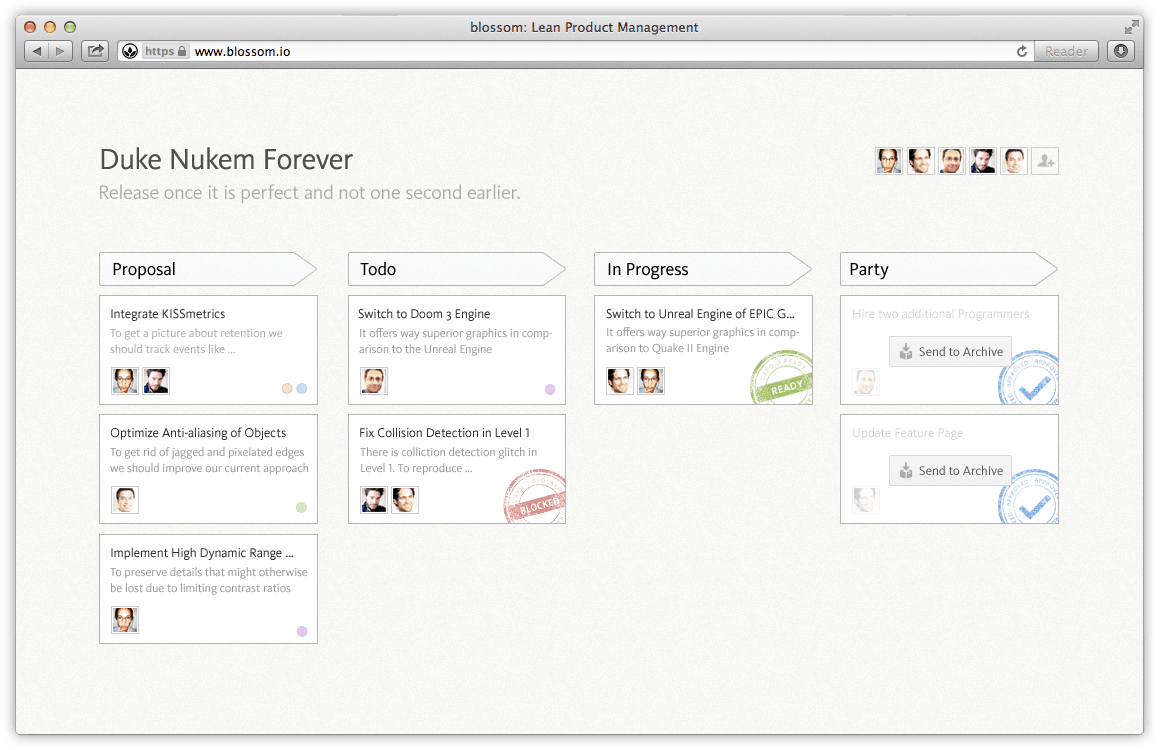The common format of Stand-Up meetings always felt a bit odd to me. It can even lead to some undesired effects.
In this post I’d like to share a few Stand-Up meeting hacks that we use at blossom.
Stand-Up meetings are a popular way to start the day for many product development teams. Usually they take around 15 minutes and are held standing up (surprise!). The idea is to keep the meeting short and to the point. With that in mind everybody goes through a routine of questions:
- What did I accomplish yesterday?
- What will I do today?
- What obstacles are impeding my progress?
I’m a huge fan of Stand-Up meetings because they are an effective way to get everyone up to date and to identify potential roadblocks ahead. Less emails, less unfocused hour-long meetings, less interruptions, more flow time. As added bonus they are also great for onboarding new team members.
Let’s look into how introducing just three simple concepts helped us to make the Stand-Up work way better for us.
1. Brew some Tea
In an ideal world people are well prepared, go through the questions quickly and start the day with élan. Unfortunately that’s not always the case. Turns out answering the usual Stand-Up meeting questions is not that easy, especially when you’re caught off-guard.
What did I do yesterday?… I can’t remember… What am I doing today?… I dunno… *
Starting the daily Stand-Up in a hurry can easily lead to busy work commitments.
That’s why we start by brewing and enjoying tea together. It’s a beautiful ritual which reminds us to slow down and to clear our minds. It connects us to the moment. A day can be full of challenges and distractions, so we want to make time to contemplate about what we do. The tea ritual acts as a buffer between the Stand-Up and whatever comes before it.
On a similar note I was quite surprised when I first saw the following HSBC ad about cultural differences which also features Stand-Up meetings 🙂
2. Get a Kanban Board
Following all the updates in a Stand-Up meeting can be difficult.
Another issue with the conventional format is that tasks or workstreams aren’t discussed coherently; instead, each subject comes up briefly depending on the order in which team members speak. This can make it hard to tell what’s really going on.
— Dave Nicolette
Constant context switching is hard to grasp and drains energy. We can make the meeting a bit easier to follow by using a Kanban board. A Kanban board is nothing more than a simple board with cards on it. You can use a physical whiteboard with post-its or a dedicated app like blossom.
A Kanban board provides context for the meeting by visualizing what’s going on at the moment.

The board shows who is working on what, which items/cards in the workflow are ready for the next stage and which items are stuck (blocked). Also, just by looking at the board you get a sense of whether you are working on too many things at the same time or if there is something interesting that you forgot to mention.
A Kanban board helps you to notice things that might easily get lost during a common Stand-Up meeting. Just grab a few post-its and try it out. You’ll be surprised how much it helps.
3. Adapt the Format
We’ve experimented a lot with the common format, added our own tea ritual, changed the strict question format to a conversation about the board and we actually don’t stand all the time (pssst!). We’re not even calling the meeting Stand-Up. We call it tea time and we might tweak more things going forward.
After all the Stand-Up is just another tool. Play around with it.
Another great example is the buffer team. Joel Gascoigne recently wrote about how they decided to include a personal-growth section in their Stand-Up routine. Looks like a great team to join if you care about self improvement and an environment that actively supports it. They are hiring.
Free yourself from the notion that the Stand-Up meeting format is carved into stone. Adapt it to your own needs and don’t shy away from adding a personal touch that fits your company culture.
I’d love to hear your Stand-Up meeting hacks.
